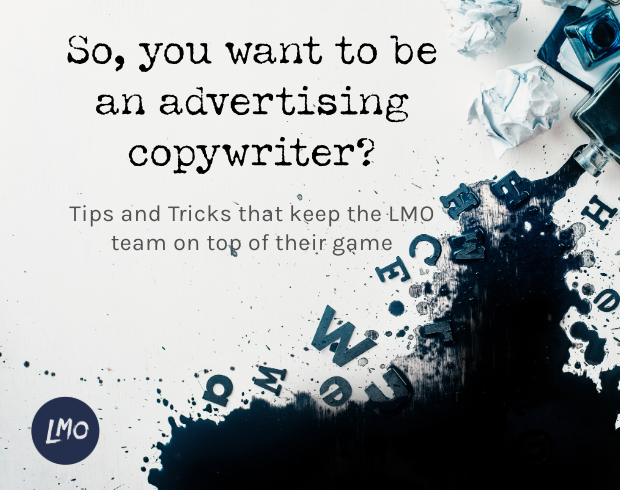So, you want to be an advertising copywriter?
At LMO, we’ve written a lot of copy for a lot of advertisements. Along the way, we’ve learned a few tips and tricks to make the process efficient, strategic and always creatively interesting.
You may be thinking, “how hard could it be? I write things all the time.” It’s true, most people do. But here’s the difference between writing and copywriting…can you do it in a precise and consistent voice while growing your audience, inspiring action and accomplishing your client’s goals? It’s easier said than done!
Writing great copy can be challenging; but like many creative challenges, it can also be a deeply rewarding collaborative endeavor. Whether you’re just starting out or you’re a seasoned veteran, these principles of effective advertising language creation will help you fend off writer’s block, keep your eye on the prize and deliver amazing copy every time.
1. Three Hour Blocks
When you sit down to work, commit to long sessions. Three hours or more per session is generally a good rule. You’ll get way more done that way. It gives you a buffer on the front end to waste time avoiding the work, which many writers actually consider an important part of the process.
Once there’s no more internet to look at, and you’ve cleaned your workspace, and you’ve taken all the bathroom breaks and coffee breaks you possibly can, you’ll still have plenty of time to get things done.
2. Quantity
Pump out a lot of bad writing and do it fast. If you’d prefer not to have your rough first attempts seen by everyone else on the team, don’t show them! The sooner you get a lot of dumb sentences that don’t make any sense and don’t accomplish any strategic goals out of your system, the sooner you’ll be able to tweak them into strong headlines, taglines, captions and so much more.
3. Bounce Ideas Off Your Designer
You’re the best writer on the team, and nobody can take that away from you. But sometimes other people have good ideas when it comes to language, too.
If you’re stumped on something, get your graphic designer’s opinion. Another reason it’s good to gut-check ideas with your creative partners: they might remember strategic guidance that uplifts the work.
4. Where Did You Repeat Yourself?
So, you’ve followed all this great advice, and now you’ve completed the first drafts of your copy assignments. Should you go back and look for grammar and spelling errors? You certainly can, but someone else is probably going to do that for you. What you should definitely do, however, is read through everything you’ve written and identify moments where you’ve repeated yourself.
Did you use the same basic structure for two posts in a row? Did you use the word “exquisite” multiple times? Are you too reliant on rhetorical questions as a device?
Writers are creatures of habit, and we lean on what we perceive as our best stuff subconsciously. Only in the rearview mirror does this kind of thing become apparent. You don’t want the client to point it out to you in review, it’s embarrassing (we’ve been there).
5. “What’s the Truest Thing You Can Say About ____?”
This is one of our favorite pieces of advertising advice and it applies here for sure. You want to find the truest thing you can say about your product or brand. Here’s a tip: the truth and the facts are not always one and the same.
Here’s an excerpt on this topic from Luke Sullivan’s classic book on copywriting, Hey Whipple, Squeeze This:
“Clients generally love facts because they can measure them—plus, they fit on charts. Facts on charts are why you’ve heard “Milk builds strong bones” since you were in second grade. Problem is, nobody cares milk builds strong bones. Have you ever found yourself poking at the bone in your arm telling a friend, “No, seriously, does this feel soft to you? C’mon, feel it.”
Meanwhile, using truth, Goodby Silverstein + Partners figured out how to sell milk by the trainload. Their strategist, John Steele, sent researchers into paid participant’s homes to live, shop, and cook with the families. The unleveraged consumer insight they identified was this: consumers buy milk because milk “goes with things.”
Think about it. Nobody sits down to pour a bowl of milk. They sit down for a bowl of cereal. Are you having cookies? Some cake? A big fat peanut-butter-and-jelly sandwich? Man, I hope you got some milk around.
This is how the explosively effective got milk? campaign was born.”
You’ve got some copywriting to do. Lucky you! It’s a great creative challenge, and your work could reach hundreds, or hundreds of thousands, or even millions of people. Remember, copy writing is an art and LMO is here to be your artist.
As the expression goes, Rome wasn’t built in a day. Honing your copywriting skills takes time, but it is a great opportunity to put some cool stuff into the world.




